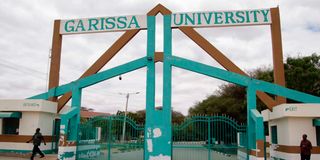Premium
Garissa University shrugs off terror raid, thrives again

Nation Media Group Commercial Manager James Sogoti (right) is given a tour of Garissa University by Vice Chancellor Irura Ng’ang’a (centre) on March 13, 2023.
This monument was constructed in memory of 148 souls massacred in cold blood by ... al-Shabaab [terrorists] on Thursday, April 2, 2015 ... Verily, the power of education will never be silenced even by the deadliest gun.”
These are some of the words inscribed on a monument at Garissa University in memory of students who died during the horrific massacre after four gunmen stormed the university and started firing indiscriminately.
The attackers took more than 700 students hostage, singled out those identified as Christians and shot them dead as they roamed from one building to the next. When the guns went silent, 148 people lay dead and at least 79 were injured.
The siege ended when all four attackers were killed. Five other men were later arrested in connection with the attack, the deadliest in Kenya since the 1998 US embassy bombings. It shook the country and the world to the core and negatively impacting on Garissa University’s image, affecting enrolment.
However, a visit to the institution by this writer alongside Nation Media Group (NMG) Commercial General Manager James Sogoti, and NMG Business Solution Manager Duncan Mbuthia found a university that was slowly regaining its footing.
Enhanced security
Security has been enhanced at the main gate with every vehicle thoroughly checked by hawk-eyed soldiers in combat gear. Students without identification cards are not allowed in. At the memorial park where the monument has been erected, trees planted by, among others, former President Uhuru Kenyatta, President William Ruto, Garissa Governor Nathif Jama, Defence Cabinet Secretary Aden Duale and former National Assembly Speaker Francis Ole Kaparo, offer shade and ambience for the learners.
“We now conduct some of the lessons here. You can see the seats. The place is also cool and comfortable,” Dr Iddi Juma, the university librarian, said. Dr Juma, who was six months old at the institution after moving from Masinde Muliro University with his family, witnessed the terrible killings with his children as they were about to leave for school but now says things have calmed down.

Garissa University's main entrance on March 13, 2023. The institution is coming up with programmes that will incorporate the local community in understanding and embracing cohesion, security and peace as a medium of development.
As the management took the NMG team on a tour of the institution, a university council meeting went on on the first floor of the administration block, and construction works of a library to also host the School of Information Sciences continued while some students hawked cookies to their colleagues on the way to the hostels.
The walls at Ewaso Ngiro Hostel, which bore the brunt of the al-Shabaab attack, are pockmarked with bullet holes. However, a new multimillion-shilling facility with a capacity to host 900 students is also complete and will host a conference hall and indoor games. A new tuition block is also under construction.
In a show of resilience, the university, which had 750 students in the first year and second year of studies during the attack, now has 1,700 students, the Deputy Vice-Chancellor in charge of Finance, Prof Irura Ng’ang’a, told Nation.
Negative impact
Prof Irura said the attack negatively impacted on the university’s enrolment as students shunned it with nearly half of those placed there by the Kenya Universities and Colleges Central Placement Service failing to report. Those who did later sought transfers.
“Most students fear being admitted here. Parents fear. Most of those who accept admission are from humble backgrounds and cannot manoeuvre their way out. We, however, charge cheaper fees. We are yet to recover from the attack but the situation is improving. We need to change people’s perception of the university,” Prof Irura said.
With a capacity of between 2,000 and 3,000 students, the only full-fledged public university in northern Kenya is usually allocated about 750 students but only about 150 report. Of the 150, half transfer to other institutions, leaving Garissa University to only run 11 programmes.
“We can’t give up because we will be succumbing to terrorism. We can’t give in to fear. The university must grow and take in more students,” Prof Irura said. The university has four schools — Pure and Applied Sciences, Business and Economics, Education, Art and Social Sciences, Institute of Peace and Security Studies.
The university, a former constituent college of Moi University, started the Institute of Peace and Security Studies after the 2015 massacre targeting national government administrators and security personnel at the certificate level. It is now offering diplomas for the course and has developed a curriculum up to PhD level. The Embassy of Switzerland has also been helping the university in its outreach activities.

Nation Media Group Commercial General manager James Sogoti chats with Garissa speaker Abdi Idre (left) outside the county assembly in Garissa town during a courtesy call on March 13, 2023.
“For instance, we are teaching players in the security sector not to use violence to quell chaos but peaceful measures,” Dr Iddi Juma, who is registrar of Academic and Student Affairs, said, adding that the university has also been getting advice and help from the National Counter Terrorism Centre.
Fears over insecurity have also affected other academic institutions in the county, with North Eastern National Polytechnic having only 40 out of the 300 called up to join the institution reporting despite accommodation fees being lowered to Sh5, 000 per term. The Polytechnic has a total of 1,400 students.
Polytechnic Deputy Principal (Academics) Margaret Wanjiru and Registrar John Githinji attributed the low enrolment to security fears.
Governor Jama said it was wrong for the region to continue being labelled as insecure yet, in 2010 Garissa was named the most peaceful county in Kenya.
Businesses
A survey by Nation in Garissa town indicated that most businesses that were affected by the university raid and had adopted a wait-and-see attitude before fully resuming were bouncing back.
The town now enjoys a number of four-star and five-star hotels, banks, private hospitals and entertainment joints. Most non-locals who had fled the town have returned with public vehicles plying the Nairobi-Garissa route flourishing.
Most of the roadside bombings in the county have happened outside Garissa town. Mr Jama is now asking the government and the international community to probe the impact thousands of Somali refugees in the county were having on locals.




